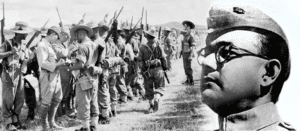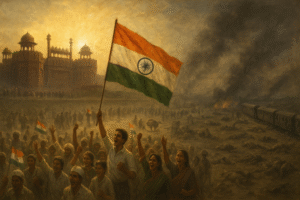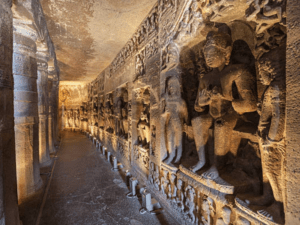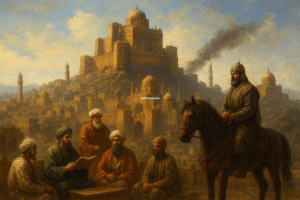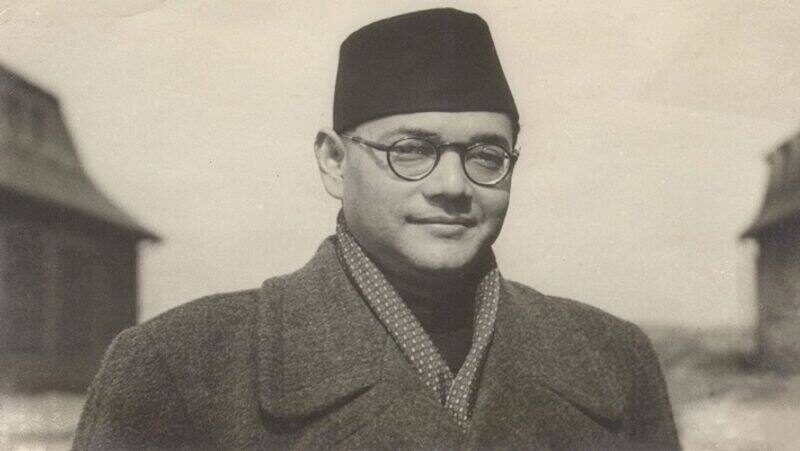
Uncovering the Legacy of The Indian Revolutionary Leader
Subhas Chandra Bose remains one of the most influential, yet often overlooked, figures in India’s struggle for independence. Many argue that he was the true force behind the British leaving India, as his revolutionary tactics, international alliances, and leadership of the Indian National Army (INA) profoundly impacted the freedom movement. His efforts were not only aimed at weakening British rule from within but also garnered significant global recognition, with his Provisional Government of Free India (Azad Hind) receiving diplomatic acknowledgment from multiple world powers before the British formally handed over power to the Indian National Congress in 1947.
This article seeks to uncover the forgotten legacy of Bose, who many believe was the real reason behind the British departure from India. His leadership, military strategy, and bold international moves stand in stark contrast to the non-violent methods of Gandhi and the Congress, offering a different but equally important path to Indian freedom.
Early Life and Ideological Formation
Subhas Chandra Bose was born on January 23, 1897, in Cuttack, Odisha, into a prosperous and well-educated Bengali family. His early years were marked by academic excellence, which led him to the University of Calcutta and later to Cambridge University in England, where he prepared for the Indian Civil Services (ICS) examination. Despite securing a top position in the ICS in 1920, Bose resigned soon after, a decision that revealed his disillusionment with British rule and his desire to dedicate his life to India’s independence.
His ideological formation was deeply influenced by Indian spiritualism, nationalist movements, and global revolutionary leaders. While many of his contemporaries, like Mahatma Gandhi, advocated for non-violent civil disobedience, Bose believed that true freedom could not be won without a more aggressive and militaristic approach. His early political career reflected this tension between moderate and radical views within the Indian National Congress (INC).
Disillusionment with Gandhi and the Congress
Bose’s association with the Indian National Congress began in the 1920s when he joined the non-cooperation movement led by Gandhi. Initially, he supported Gandhi’s philosophy of non-violence, but over time, Bose grew increasingly frustrated with the slow pace of the struggle. He believed that India could not win independence through moral persuasion alone but required a well-organized military resistance.

In the late 1920s and 1930s, Bose quickly rose through the ranks of the Congress, aligning himself with more radical leaders like Jawaharlal Nehru and Vallabhbhai Patel. In 1938, Bose was elected President of the Congress at the Haripura session, a position of great influence within the freedom movement. However, his differences with Gandhi came to a head during his second term as Congress President in 1939, when Gandhi opposed Bose’s re-election, favoring a more conciliatory approach with the British government.
Bose’s resignation from the Congress after this fallout marked a significant turning point in his political journey. Unlike Gandhi, whose strategy was focused on winning over the masses and convincing the British through non-violent means, Bose sought external allies and believed in direct confrontation. His break with the Congress was not just a personal schism; it represented a wider ideological rift in the independence movement between radicalism and moderation.
Formation of the Indian National Army (INA) and Global Recognition
Following his break with the Congress, Bose embarked on a bold and revolutionary path. In 1940, the British government placed him under house arrest for his anti-imperial activities. However, in a dramatic escape in 1941, Bose fled India, traveling through Afghanistan, the Soviet Union, and eventually arriving in Germany. There, he sought support from Adolf Hitler and the Axis Powers for India’s independence, although the German response was tepid.
Bose’s real breakthrough came in 1943 when he moved to Japan-occupied Southeast Asia, where he assumed leadership of the Indian National Army (INA), which had been formed by Indian prisoners of war and expatriates. Under Bose’s command, the INA adopted the slogan “Chalo Dilli” (On to Delhi), signaling its intent to march into India and overthrow British rule through military force.
In addition to leading the INA, Bose also established the Provisional Government of Free India, known as Azad Hind, which was officially declared in Singapore in 1943. This government-in-exile was recognized by several world powers, including Japan, Germany, Italy, and even the Soviet Union. Bose’s recognition as the Prime Minister of this government marked a significant milestone, as it established him as the legitimate leader of a free Indian state in the eyes of these global powers—years before the British would eventually hand over power to the Congress in 1947.
The creation of the INA and Azad Hind was not just a military effort but a diplomatic coup, as it challenged the very legitimacy of British rule in India. Bose’s government had its own bank, currency, and civil administration, and its international recognition further undermined British authority over India.
Was Bose’s INA Successful?
The INA, though small compared to British and Allied forces, became a symbol of Indian resistance and inspired nationalist fervor across the country. Bose’s strategic alliances with Japan and Germany were controversial, especially given the oppressive nature of these regimes. However, Bose saw them as temporary allies in the larger mission of securing India’s freedom. His military campaign, which aimed to march into India through Burma, saw some initial successes but was ultimately thwarted by logistical challenges, the superior strength of Allied forces, and Japan’s defeat in World War II.

Despite its failure to militarily liberate India, the INA’s struggle had profound political ramifications. Bose’s emphasis on unity beyond religious and caste divisions galvanized a new wave of Indian nationalism. His vision of an India free from both British imperialism and internal divisions resonated with many Indians, particularly soldiers in the British Indian Army, many of whom began questioning their loyalty to the British Crown.
The British response to the INA soldiers, whom they captured and put on trial for treason, further ignited nationalist sentiment in India. The trials of the INA soldiers in 1945-46, known as the Red Fort Trials, sparked massive public outrage. Even leaders like Nehru, who had previously disagreed with Bose’s methods, defended the INA soldiers in court, fearing that the British crackdown on these men could lead to greater unrest. The INA’s legacy thus played a critical role in undermining British confidence in maintaining control over India.
The INA’s Role in Undermining British Rule
Although the INA was ultimately unsuccessful in its military campaign to liberate India, its efforts had profound political and psychological effects on British colonial rule. The INA’s military actions, particularly in Burma and Northeast India, stretched British resources thin during World War II and inspired a new wave of nationalist fervor in India.

Bose’s leadership and vision for an independent India transcended religion, caste, and class, and he emphasized unity above all. The INA’s soldiers, who fought with unparalleled bravery, became national heroes, and their cause was seen as a symbol of resistance against colonial oppression. Even though the INA did not succeed in capturing Indian territory, its fight against the British shook the empire’s foundation.
The real impact of the INA came in the form of the trials of its soldiers. After World War II, the British arrested and tried several INA soldiers for treason in the infamous Red Fort Trials of 1945-46. The trials sparked mass protests across India, as the INA soldiers were seen as martyrs of the independence struggle. These protests unified different factions of the freedom movement, even winning over leaders like Jawaharlal Nehru, who had previously disagreed with Bose’s methods. The British were now facing a growing wave of civil unrest that threatened to spiral out of control.
Military Mutinies and British Retreat
The INA’s legacy directly contributed to one of the most critical developments that hastened the British exit: the mutinies in the British Indian military. In 1946, the Royal Indian Navy mutiny broke out, with thousands of sailors revolting against their British officers. This mutiny, along with several others across the military, was directly inspired by the INA’s actions and the growing nationalist sentiment in the country.
The British, already weakened by World War II, realized that they could no longer rely on the loyalty of Indian soldiers, who had been the backbone of their military control in India. The British Prime Minister at the time, Clement Attlee, later acknowledged that the mutinies, combined with the actions of the INA, played a decisive role in the British decision to leave India. Bose’s revolutionary leadership had not only shaken British control but had also inspired rebellion within the very military forces that the British depended on to maintain their empire.
Was Subhas Chandra Bose the True Force Behind India’s Freedom?
While Bose’s military campaign did not directly force the British to leave, his efforts significantly contributed to the weakening of British imperial authority. His impact can be measured in several ways:
- Weakening British Morale: The INA’s rebellion, though militarily unsuccessful, exposed the fragility of British control over India. By organizing an armed resistance and securing international alliances, Bose demonstrated that India’s independence was not an impossible dream but a tangible goal that could be achieved through non-traditional means.
- Inspiring Military Revolt: Bose’s leadership of the INA inspired nationalist fervor among Indian soldiers, both within and outside the British Indian Army. After World War II, the loyalty of Indian soldiers to the British crown was severely shaken. The Royal Indian Navy mutiny in 1946, which saw sailors revolting against British officers, was partly fueled by the INA’s legacy. This mutiny, combined with widespread civil unrest, convinced British authorities that maintaining colonial control over India was becoming unsustainable.
- Shifting Public Opinion: Bose’s radical approach appealed to many Indians who were frustrated by the slow pace of the non-violent struggle. His willingness to challenge the British through military means provided an alternative vision for the freedom movement. Although Gandhi remained the moral face of the independence struggle, Bose offered a different kind of leadership that appealed to the youth and to sections of society that were disillusioned with pacifism.
- Forcing the British to Rethink: Some historians argue that it was not just the moral pressure from Gandhi’s movement but also the fear of widespread rebellion, fueled by the INA’s influence, that pushed the British to hasten their departure from India. Clement Attlee, the British Prime Minister when India was granted independence, reportedly acknowledged that the INA and the threat of military revolt played a key role in the British decision to leave India.
Legacy and Controversies
Subhas Chandra Bose’s legacy remains deeply complex and controversial. While his contributions to India’s freedom struggle are undeniable, his alliances with fascist regimes like Nazi Germany and Imperial Japan continue to cast a shadow over his reputation. His alliances with the Axis Powers were controversial, but Bose was focused solely on his goal of liberating India. For him, the struggle for independence justified any alliance, as long as it helped break the chains of British colonialism.
For many, Bose was a revolutionary hero who was willing to risk everything for India’s freedom. For others, his collaboration with brutal regimes raises ethical questions about his judgment and the long-term vision he had for India’s future.
One of the most important but often overlooked aspects of Bose’s legacy is the international recognition he received as the leader of India’s independence movement. The Provisional Government of Free India was not merely symbolic—it was a functioning government that received diplomatic acknowledgment from world powers. By establishing embassies in countries like Japan, Germany, and Italy, Bose showed that India’s independence was a global issue, not just a domestic struggle.
Bose’s vision of a free India was not limited to mere independence from British rule. He advocated for an inclusive, secular, and industrialized nation that would be strong and self-reliant on the global stage. His ideas on social justice, national unity, and economic development were ahead of his time, influencing the future trajectory of Indian politics and governance.
The Revolutionary Neta Ji Subhas Chandra Bose
While it is impossible to designate a single “true force” behind India’s freedom, Subhas Chandra Bose’s contributions were undoubtedly pivotal in shaping the final phase of the independence movement. His revolutionary methods, international alliances, and the formation of the Indian National Army added a new dimension to the struggle that went beyond the tactics of civil disobedience. Though his military campaigns did not directly win India’s freedom, they played a significant role in undermining British authority and inspiring a new wave of nationalism that ultimately hastened the end of colonial rule.

Bose’s vision of an independent, united, and self-reliant India laid the foundation for the nation’s future, and his legacy as a true hero of the freedom movement remains an inspiration for generations to come.

